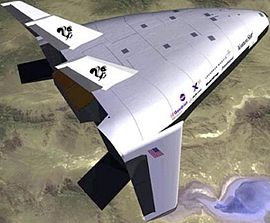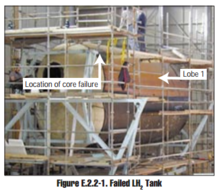
Simulated in-flight view of the X-33
| |
| Function | Unmanned re-usable spaceplane technology demonstrator |
|---|---|
| Manufacturer | Lockheed Martin |
| Country of origin | United States |
| Project cost | $922 million NASA + $357 million Lockheed Martin |
| Size | |
| Height | 20 m (69 ft) |
| Diameter | N/A |
| Mass | 285,000 lb (130,000 kg) |
| Stages | 1 |
| Capacity | |
| Launch history | |
| Status | Canceled (2001) |
| Total launches | 0 |
| First stage - X-33 | |
| Engines | 2 XRS-2200 linear aerospikes |
| Thrust | 410,000 lbf (1.82 MN) |
| Fuel | LOX/LH2 |
The Lockheed Martin X-33 was an unmanned, sub-scale technology demonstrator suborbital spaceplane developed in the 1990s under the U.S. government-funded Space Launch Initiative program. The X-33 was a technology demonstrator for the VentureStar orbital spaceplane, which was planned to be a next-generation, commercially operated reusable launch vehicle. The X-33 would flight-test a range of technologies that NASA believed it needed for single-stage-to-orbit reusable launch vehicles (SSTO RLVs), such as metallic thermal protection systems, composite cryogenic fuel tanks for liquid hydrogen, the aerospike engine, autonomous (unmanned) flight control, rapid flight turn-around times through streamlined operations, and its lifting body aerodynamics.
Failures of its 21-meter wingspan and multi-lobed, composite material fuel tank during pressure testing ultimately led to the withdrawal of federal support for the program in early 2001. Lockheed Martin has conducted unrelated testing, and has had a single success after a string of failures as recently as 2009 using a 2-meter scale model.
History
In 1994 NASA initiated the Reusable Launch Vehicle (RLV) program, which among other things lead to the development of the X-33 within a few years. Another important vehicle in this program was the Orbital Sciences X-34, which was developed concurrently with the X-33 by 1996.
Goals of the RLV program:
- To "demonstrate technologies leading to a new generation of space boosters capable of delivering payloads at significantly lower cost"
- To "provide a technology base for development of advanced commercial launch systems that will make U.S. aerospace manufacturers more competitive in the global market."
The proposals for the X-33 included designs from:
- Rockwell
- Lockheed Martin
- McDonnell Douglas
The X-33 contract was awarded to LM in 1996, and $1 billion was spent
through 1999 with about 80 percent coming from NASA and additional
money contributed by private companies. The goals was to have a first flight by 1999, and operating space vehicle by 2005.
... to build a vehicle that takes days, not months, to turn around; dozens, not thousands, of people to operate; with launch costs that are a tenth of what they are now. Our goal is a reusable launch vehicle that will cut the cost of getting a pound of payload to orbit from $10,000 to $1,000.
— D. Goldin NASA administrator on the RLV program
There were three design proposals submitted for the X-33, and the L.M. version won and was further developed. The Lockheed Martin proposal was chosen on July 2, 1996.
However, the X-33 program was cancelled in early 2001 after the project
had problems with a carbon composite hydrogen fuel tank. The program was managed by the NASA's Marshall Space Flight Center.
Several years after it was cancelled the problems with hydrogen fuel tank were resolved by aerospace companies.
Design and development
X-33 model being prepared for testing in a wind-tunnel in 1997
Test of the X-33's thermal protection system, 1998
Space art of X-33 in orbit
Another concept of it in space
Through the use of the lifting body shape, composite multi-lobed liquid fuel tanks, and the aerospike engine, NASA and Lockheed Martin hoped to test fly a craft that would demonstrate the viability of a single-stage-to-orbit
(SSTO) design. A spacecraft capable of reaching orbit in a single
stage would not require external fuel tanks or boosters to reach low
Earth orbit. Doing away with the need for "staging" with launch
vehicles, such as with the Shuttle and the Apollo rockets, would lead to
an inherently more reliable and safer space launch vehicle. While the
X-33 would not approach airplane-like safety, the X-33 would attempt to
demonstrate 0.997 reliability, or 3 mishaps out of 1,000 launches, which
would be an order of magnitude more reliable than the Space Shuttle. The 15 planned experimental X-33 flights could only begin this statistical evaluation.
X-33 launch facility already completed at Edwards Air Force Base.
The unmanned craft would have been launched vertically from a specially designed facility constructed on Edwards Air Force Base, and landed horizontally (VTHL) on a runway at the end of its mission. Initial sub-orbital test flights were planned from Edwards AFB to Dugway Proving Grounds southwest of Salt Lake City, Utah.
Once those test flights were completed, further flight tests were to be conducted from Edwards AFB to Malmstrom AFB in Great Falls, Montana, to gather more complete data on aircraft heating and engine performance at higher speeds and altitudes.
On July 2, 1996, NASA selected Lockheed Martin Skunk Works of Palmdale, California,
to design, build, and test the X-33 experimental vehicle for the RLV
program. Lockheed Martin's design concept for the X-33 was selected
over competing designs from Boeing and McDonnell Douglas. Boeing featured a Space Shuttle-derived design, and McDonnell Douglas featured a design based on its vertical takeoff and landing (VTVL) DC-XA test vehicle.
The unmanned X-33 was slated to fly 15 suborbital hops to near 75.8 km altitude.
It was to be launched upright like a rocket and rather than having a
straight flight path it would fly diagonally up for half the flight,
reaching extremely high altitudes, and then for the rest of the flight
glide back down to a runway.
The X-33 was never intended to fly higher than an altitude of
100 km, nor faster than one-half of orbital velocity. Had any
successful tests occurred, extrapolation would have been necessary to
apply the results to a proposed orbital vehicle.
The decision to design and build the X-33 grew out of an internal NASA study titled "Access to Space". Unlike other space transport studies, "Access to Space" was to result in the design and construction of a vehicle.
Commercial spaceflight
Based on the X-33 experience shared with NASA, Lockheed Martin hoped to make the business case for a full-scale SSTO RLV, called VentureStar,
that would be developed and operated through commercial means. The
intention was that rather than operate space transport systems as it has
with the Space Shuttle,
NASA would instead look to private industry to operate the reusable
launch vehicle and NASA would purchase launch services from the
commercial launch provider. Thus, the X-33 was not only about honing
space flight technologies, but also about successfully demonstrating the
technology required to make a commercial reusable launch vehicle
possible.
The VentureStar was to be the first commercial aircraft to fly
into space. The VentureStar was intended for long inter-continental
flights and supposed to be in service by 2012, but this project was
never funded or begun.
Aerospike engine test at Stennis Space Center, August 6, 2001
Cancellation
The program was cancelled in February 2001. The main reason for this was reported as being a delay caused in completing the fuel tanks.
Construction of the prototype was some 85% assembled with 96% of the parts and the launch facility 100%
complete when the program was canceled by NASA in 2001, after a long
series of technical difficulties including flight instability and excess
weight.
In particular, the composite liquid hydrogen fuel tank failed
during testing in November 1999. The tank was constructed of honeycomb
composite walls and internal structures to reduce its weight. A lighter
tank was needed for the craft to demonstrate necessary technologies for
single-stage-to-orbit operations. A hydrogen fueled SSTO craft's mass fraction requires that the weight of the vehicle without fuel
be 10% of the fully fueled weight. This would allow a vehicle to fly
to low Earth orbit without the need for the sort of external boosters
and fuel tanks used by the Space Shuttle. But, after the composite tank
failed on the test stand during fueling and pressure tests, NASA came to
the conclusion that the technology of the time was simply not advanced
enough for such a design. While the composite tank walls themselves
were lighter, the odd hydrogen tank shape resulted in complex joints
increasing the total mass of the composite tank to above that of an
aluminum-based tank.
Microcracking problem discovered in the liquid-hydrogen (LH2) multi-lobed tank core by NASA scientists at Goddard Space Flight Center ultimately caused NASA to cancel the X-33 program
NASA had invested $922 million in the project before cancellation,
and Lockheed Martin a further $357 million. Due to changes in the space
launch business—including the challenges faced by companies such as Globalstar, Teledesic, and Iridium
and the resulting drop in the anticipated number of commercial
satellite launches per year—Lockheed Martin deemed that continuing
development of the X-33 privately without government support would not
be profitable.
Specifications
- Length: 69 feet (21 m)
- Width: 77 feet (23 m)
- Takeoff weight: 285,000 pounds (129,000 kg)
- Fuel: LH2/LO2
- Fuel weight: 210,000 pounds (95,000 kg)
- Main Propulsion: 2 XRS-2200 linear aerospikes
- Take-off thrust: 410,000 pounds-force (1,800,000 N)
- Maximum speed: > Mach 13 (16,000 km/h)
- Payload to low Earth orbit: N/A
Continued research
After the cancellation in 2001, engineers were able to make a working liquid-oxygen tank from carbon-fiber composite. Tests showed that composites were feasible materials for liquid-oxygen tanks.
On September 7, 2004, Northrop Grumman and NASA engineers
unveiled a liquid-hydrogen tank made of carbon-fiber composite material
that had demonstrated the ability for repeated fuelings and simulated
launch cycles.
Northrop Grumman concluded that these successful tests have enabled
the development and refinement of new manufacturing processes that will
allow the company to build large composite tanks without an autoclave; and design and engineering development of conformal fuel tanks appropriate for use on a single-stage-to-orbit vehicle.
The alternative proposals
Five
companies expressed interest and proposed concepts. Three (LM, Rockwell
and McDonnell Douglas) were selected for workup into more detailed
proposals.
Rockwell
Rockwell proposed a Space Shuttle-derived design. It would have used one Space Shuttle Main Engine (SSME) and two RL-10-5A engines.
In a subsequent full-scale system to reach orbit Rockwell planned to use six Rocketdyne RS-2100 engines.
McDonnell Douglas
McDonnell Douglas featured a design using liquid oxygen/hydrogen bell engines based on its vertical takeoff and landing (VTVL) DC-XA test vehicle. It would have used a single SSME for the main propulsion system.







